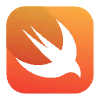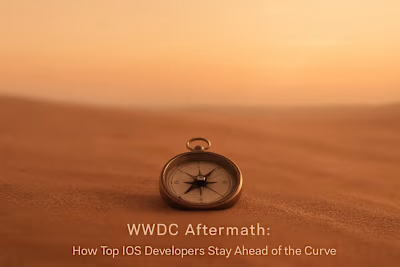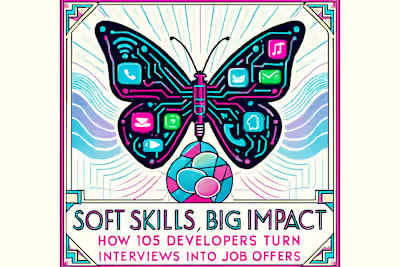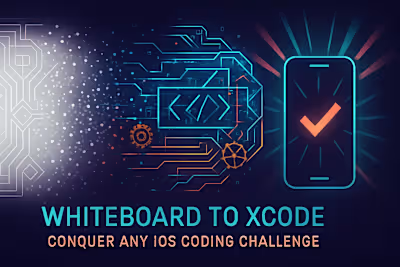More Than Code: Build Your Personal Brand to Attract High-Value iOS Projects
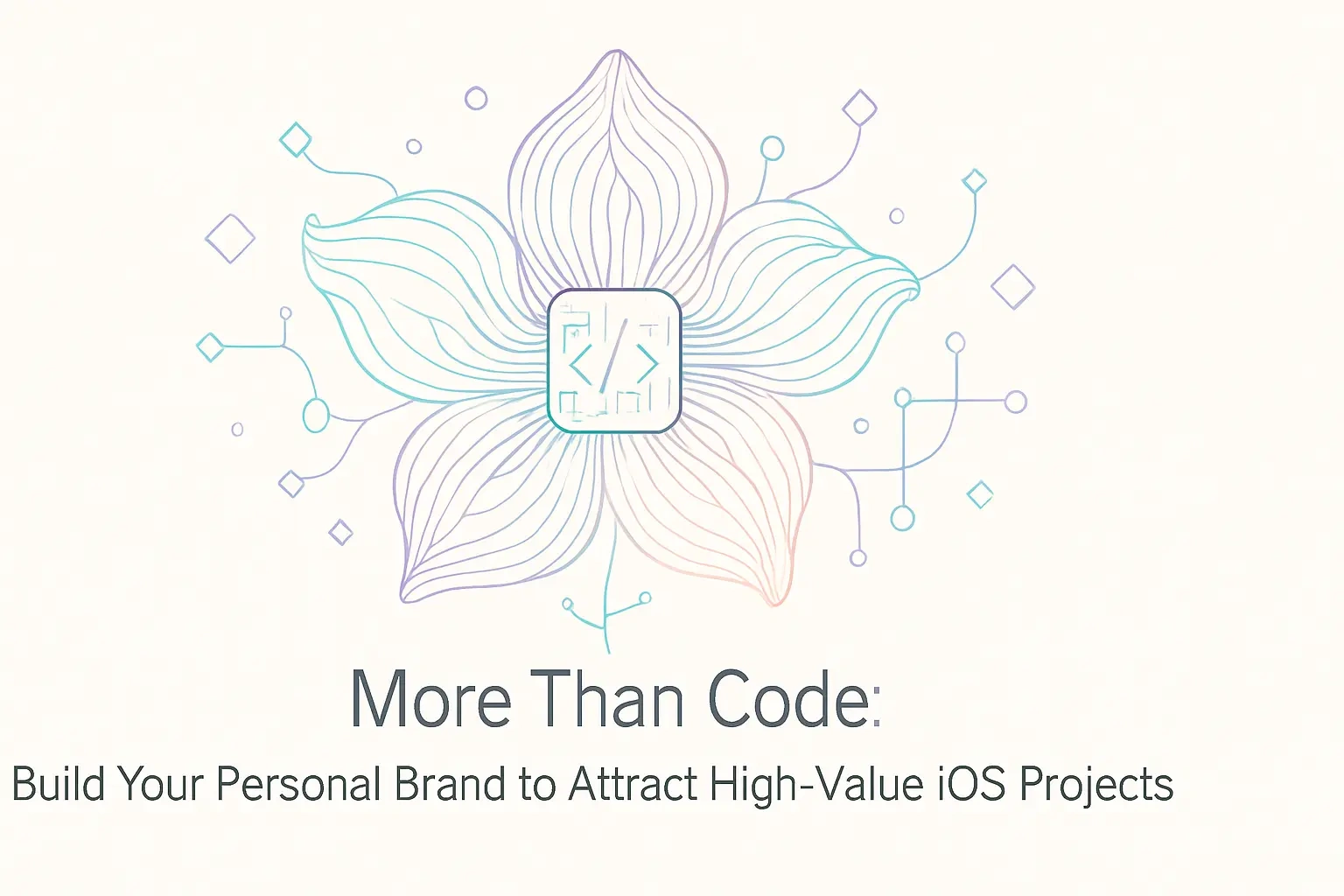
More Than Code: Build Your Personal Brand to Attract High-Value iOS Projects
The Power of the Pen: Getting Started with Blogging
Finding Your Niche and Voice
Turning Project Challenges into Compelling Blog Posts
Giving Back and Gaining More: Contributing to Open Source
How to Find Beginner-Friendly iOS Projects
Making Your First Contribution: From Fork to Pull Request
Taking the Stage: The Impact of Public Speaking
Finding Speaking Opportunities
Crafting a Compelling Technical Talk
Conclusion
References
More Than Code: Build Your Personal Brand to Attract High-Value iOS Projects
In the world of iOS development, technical expertise is the price of entry. But what separates a good developer from a sought-after one? The answer is a strong personal brand. Building a brand allows you to demonstrate your value beyond a resume, attracting better projects and higher rates.
It's a natural extension of keeping your skills sharp and a crucial element for building a strong professional network. This article explores three powerful pillars of brand-building for iOS developers: blogging, open source contributions, and public speaking.
The Power of the Pen: Getting Started with Blogging
Writing is a direct way to showcase your problem-solving process and deep knowledge. It establishes you as an expert who can not only code but also communicate complex ideas clearly—a highly valuable skill.
Think about the last time you searched for a solution to a tricky iOS problem. Chances are, you found your answer in someone's blog post. That developer didn't just solve their problem; they took the time to share it with the world. Now imagine being that person for someone else.
Blogging does more than help others. It forces you to organize your thoughts and truly understand what you're building. When you write about code, you can't hide behind vague explanations. You need to break down complex concepts into digestible pieces. This process makes you a better developer and communicator.
The best part? You don't need to be perfect. Your blog is a record of your growth. Those early posts about basic UIKit concepts will show future clients how far you've come. They demonstrate continuous learning—a trait every client values.
Finding Your Niche and Voice
You don't need to be the world's foremost expert. Focus on what you're learning or challenges you've overcome. Topics can range from a deep dive into a niche SwiftUI feature to a post about your productivity workflow. Authenticity is key.
Start by looking at your recent work. What made you scratch your head last week? What solution made you feel proud? These moments are gold for blog content. Maybe you figured out a clever way to handle deep linking in your app. Or perhaps you discovered a performance optimization that cut your app's load time in half.
Your voice matters as much as your topic. Write like you're explaining something to a colleague over coffee. Skip the formal academic tone. Use "I" and "you." Share your frustrations and victories. Readers connect with real experiences, not textbook explanations.
Consider mixing technical posts with broader topics. Write about your development setup. Share your thoughts on the latest iOS release. Discuss how you balance learning new frameworks with project deadlines. This variety shows you're not just a coder but a well-rounded professional.
Turning Project Challenges into Compelling Blog Posts
Every bug fixed or complex feature built is a potential blog post. Frame your articles as case studies: "Here was the problem, here was my thought process, and here is the solution I built." This provides immense value to other developers.
Let's say you spent three days wrestling with a Core Data migration issue. Don't just move on after fixing it. That struggle is content gold. Start your post by describing the initial problem. What error messages did you see? What was the expected behavior versus what actually happened?
Then walk through your debugging process. Share the Stack Overflow posts that didn't work. Mention the documentation you misunderstood at first. This honesty makes your content relatable and trustworthy. Other developers will see themselves in your struggle.
When you present the solution, break it down step by step. Include code snippets, but keep them focused. Explain why your solution works, not just how. This deeper understanding sets your content apart from quick fix tutorials.
End with lessons learned. What would you do differently next time? What resources helped most? These reflections turn a simple tutorial into a valuable learning experience for your readers.
Giving Back and Gaining More: Contributing to Open Source
Contributing to open source is a public demonstration of your coding skills, your ability to collaborate, and your commitment to the developer community. It's a powerful signal to potential clients and collaborators.
Open source contributions are like a public portfolio that never sleeps. While your private client work stays hidden behind NDAs, your open source work is visible to everyone. It shows real code, real problem-solving, and real collaboration skills.
But the benefits go beyond visibility. Working on open source projects exposes you to different coding styles and architectures. You'll see how senior developers structure large projects. You'll learn new patterns and best practices. This exposure makes you a more versatile developer.
The networking aspect is equally valuable. Open source projects connect you with developers worldwide. That person reviewing your pull request today might recommend you for a project tomorrow. These connections often lead to opportunities you'd never find through traditional job boards.
How to Find Beginner-Friendly iOS Projects
Start small. Look for projects with "good first issue" or "help wanted" labels on GitHub. Contributing doesn't always mean writing complex code; it can be improving documentation, writing tests, or fixing minor bugs.
Begin with projects you actually use. Check if your favorite iOS libraries need help. When you use a tool daily, you understand its purpose and can make meaningful contributions. Plus, improving tools you rely on directly benefits your own work.
Documentation is an excellent entry point. Many projects have great code but poor documentation. Fixing typos, adding examples, or clarifying confusing sections are valuable contributions. These tasks help you understand the codebase without diving into complex features.
Look for projects with active maintainers. Check the recent commit history and pull request activity. Active projects mean your contributions will get reviewed and merged faster. This quick feedback loop keeps you motivated and learning.
Don't overlook smaller projects. While contributing to Alamofire or RxSwift looks impressive, smaller projects often need more help and give you more impact. You might even become a core contributor faster than you'd expect.
Making Your First Contribution: From Fork to Pull Request
Walk through the fundamental Git workflow for contributing: forking a repository, creating a new branch for your changes, committing your work with clear messages, and submitting a pull request for review.
First, fork the repository to your GitHub account. This creates your personal copy where you can experiment freely. Clone this fork to your local machine and set up the original repository as an upstream remote. This setup lets you keep your fork synchronized with the main project.
Create a new branch for your specific contribution. Name it descriptively, like "fix-navigation-memory-leak" or "add-dark-mode-support." This organization helps maintainers understand your changes at a glance.
Make your changes in small, logical commits. Each commit should represent one complete thought. Write clear commit messages that explain what changed and why. "Fixed bug" tells nothing, but "Fixed memory leak in NavigationController by properly releasing observers" tells the whole story.
Before submitting your pull request, run the project's tests. Add new tests if you're adding features. Update documentation if needed. These extra steps show professionalism and respect for the project's standards.
When you open your pull request, write a thorough description. Explain the problem you're solving and how your code solves it. Link to relevant issues. Include screenshots for UI changes. This context helps reviewers understand and approve your work faster.
Taking the Stage: The Impact of Public Speaking
Public speaking, whether at a local meetup or a large conference, positions you as a leader in the field. It's a direct line to building authority and making high-value connections.
Standing in front of an audience changes how people perceive you. You're no longer just another developer in the crowd. You're the expert sharing knowledge. This shift in perception translates directly to career opportunities.
Speaking engagements create a multiplier effect for your personal brand. One talk can reach hundreds of developers. The conference might record and share your talk online, reaching thousands more. Compare that reach to a blog post or tweet. The impact is massive.
The preparation process itself makes you better. Creating a talk forces you to deeply understand your topic. You anticipate questions and edge cases. You find clearer ways to explain complex concepts. This deep dive improves your expertise beyond the talk itself.
Finding Speaking Opportunities
Start with local developer meetups. These are often looking for speakers and provide a friendly environment to get started. From there, you can submit proposals to regional or international conferences.
Your local iOS or Swift meetup is the perfect starting point. These groups constantly need speakers and welcome first-timers. The audience is smaller and more forgiving. You might even know some attendees, making the experience less intimidating.
Lightning talks offer another gentle entry. These 5-10 minute presentations let you test ideas without committing to a full session. Many conferences include lightning talk sessions that accept day-of submissions. It's low pressure but high impact.
Once comfortable, look for regional conferences. These events are more formal than meetups but less competitive than major conferences. They often focus on community building and welcome new speakers. Check their websites for CFP (Call for Proposals) deadlines.
Virtual conferences opened new opportunities. You can speak at events worldwide without travel costs. The online format feels less intimidating for many first-time speakers. Plus, you can practice your talk in your comfortable home environment.
Crafting a Compelling Technical Talk
A good talk tells a story. Structure your presentation around a problem and a solution. Use clear visuals and live code demos to engage the audience. Focus on providing practical, actionable takeaways.
Start with a problem your audience faces. Maybe it's managing complex state in SwiftUI. Or handling background tasks efficiently. Whatever you choose, make sure your audience feels the pain. They should think, "Yes, I struggle with this too!"
Build tension before revealing your solution. Show why obvious approaches fail. Demonstrate the frustration. This narrative structure keeps audiences engaged better than jumping straight to the answer.
Live coding can be powerful but risky. If you choose to code live, practice extensively. Have backup slides ready. Keep the code examples focused and simple. The audience should follow your logic, not debug syntax errors.
Visual aids should support, not distract. Use diagrams to explain architecture. Show before-and-after code comparisons. Include screenshots of real apps using your technique. But avoid walls of text or complex slides that compete with your words.
End with clear next steps. What should the audience do tomorrow? Provide links to sample code. Suggest specific techniques to try. Give them tools to implement what they learned. This practical focus transforms inspiration into action.
Remember to inject personality into your talk. Share a relevant failure story. Add appropriate humor. Show enthusiasm for your topic. Technical content doesn't mean boring delivery. Your passion is contagious.
Conclusion
Building your personal brand as an iOS developer isn't about self-promotion or ego. It's about creating value for others while establishing yourself as a trusted expert. Through blogging, you share knowledge and improve your communication skills. Open source contributions prove your technical abilities and collaborative spirit. Public speaking positions you as a leader and connector in the community.
These activities compound over time. Your first blog post might get ten views. Your first pull request might fix a typo. Your first talk might be to twenty people at a local meetup. But consistency creates momentum. That tenth blog post could land you a dream client. That ongoing open source contribution could lead to a job offer. That conference talk could spark a partnership.
Start small but start today. Pick one area that excites you most. Write that first blog post about the bug you fixed yesterday. Submit that pull request to fix documentation. Apply to speak at next month's meetup. Each action builds your brand and opens doors you didn't know existed.
The iOS development world needs more voices, more contributors, more teachers. Your unique perspective and experience have value. Share them. The community will be better for it, and so will your career.
References
Like this project
Posted Jul 6, 2025
Stand out in a crowded market. Discover how blogging, contributing to open source, and public speaking can elevate your iOS developer career and attract high-value clients.


